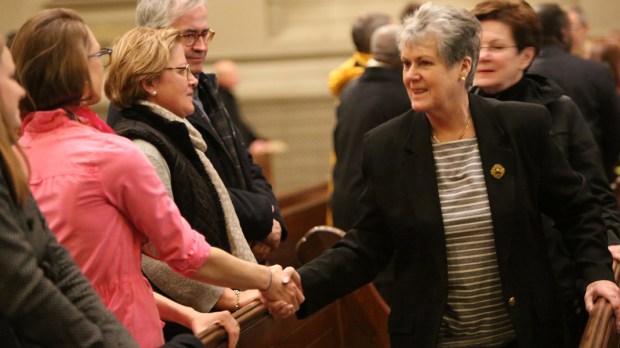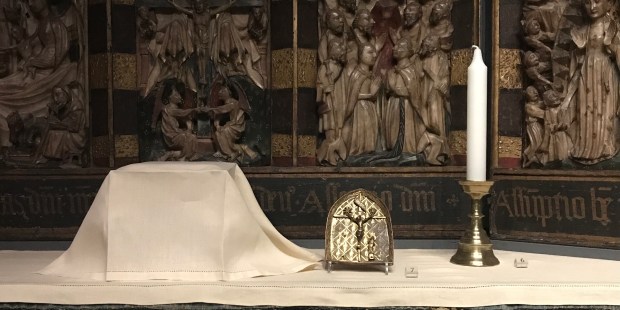Five decades after it was revived, the Sign of Peace still has many a Mass-goer perplexed. The confusion grows as one digs deeper into its long history.
The Kiss of Peace, as it was once known, hardly happened before the COVID era. What was for centuries a vital part of the Mass had already been replaced by nods, handshakes and the occasional daring hug. The original ritual had its own accessory, which is as rarely seen today as the kiss itself. This instrument was known by various names, the simplest of which was the very straightforward “Pax board.”
The kissing of the “Pax”
For centuries the Pax (the Latin word for peace) would be kissed by the officiating priest before communion and then passed to other priests and deacons at the altar. From there it was taken to the congregation.
There are numerous ancient accounts of how the Pax worked, and these don’t always align with each other. There also a large number of the instruments themselves still extant. One puzzle, for me at least, is how seldom they appear in paintings of the Mass being celebrated. Surely we should be able to see them on every altar that has been depicted during the four centuries they were in common use?
Strangely, we do not. Part of the reason is that of the vast number of religious paintings, relatively few show the Mass. Most artists and patrons preferred to focus on the original happenings rather than the daily re-enactment in their local church. The main exception to this shortage is a specific event, such as the Mass of St. Gregory. On this legendary occasion, Pope Gregory I and the congregation experienced the actual presence on the altar. Out of the chalice appeared Our Lord, which must have settled the issue for any doubters who were present.
It is not surprising that the Pax seldom appears in these paintings. There is always a chalice, paten, missal and candlesticks, but no need for the celebrant to kiss the image of Jesus when he was fully present.
A hygienic solution to kissing in the pews
The purpose of the Pax was to create a connection with Christ. The kiss of peace was a transmission from God to priest, who then passed it on to the congregation.
Men and women were at one time segregated in Catholic churches, as is still the case with most Orthodox parishes. After more than a thousand years of this practice, medieval Catholics allowed more mixing of the sexes at Mass and began to favor the use of a Pax. In addition to issues of hygiene, this calmed some of the moral concerns about over-vigorous kissing. It was in England that the use of a neutral, inanimate instrument seems to have started replacing direct human contact.
During those pre-Reformation days, England was a significant part of the Catholic world, producing some of the finest devotional art. The Pax board was another item crafted by virtuoso Englishmen from the 13th century onward. Usually flat, they were crafted from metal, wood and ivory. The imagery usually represented the life of Christ, especially the crucifixion, but could also feature the Virgin Mary or symbols of the faith.
The size of a Pax was dictated by the need to pass it around a church. It had to be at least a few inches high to prevent it being lost among the crowd; nor could it be too big and cumbersome. A handle was usually attached to the back to facilitate passing along. Sometimes it was attached to a pole and presented to each participant by a dedicated Pax operator. Often there would be a second person to wipe the Pax after every kiss.
The way the Pax was used differed in various parts of Christendom. In some places it was for the clergy only; in others it was for the clergy and high-status congregants. Mostly, it was for everyone who approached the altar.
Eventually the Pax fell out favor everywhere, although it does appear occasionally at the Extraordinary Form of the Mass. Instead of bringing the peace of Christ to individual worshipers and bringing communities together, it often stoked dissension. An order of precedence emerged that managed to displease countless male and female worshipers. Geoffrey Chaucer, the so-called father of English literature, should have the last word with his comments on a proud man in the Canterbury Tales:
“… he awaiteth to sit, or els to go above him in the waie, or kisse paxe, or be encenced before his neighbour …”
Or maybe he shouldn’t have the last word. Chaucer’s form of English is mostly incomprehensible to modern eyes. Thomas More is easier to understand when he complained that, “men fall at variance for kissing of the pax.”
No less a writer than Shakespeare also mentioned the Pax, despite living after the Reformation. His knowledge of the Mass was greater than later editors who changed his text about a man who had “stolen a pax … of little price” to a “stolen a pyx” (a container for the consecrated Hosts). One of these editors was Dr Samuel Johnson, who seemed to be unaware of the Pax. Shakespeare, on the other hand, is thought to have had hidden Catholic sympathies along with a good memory of practices that had been eradicated.


